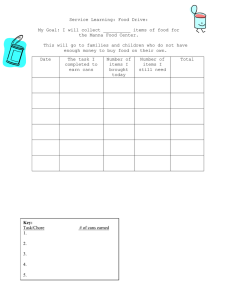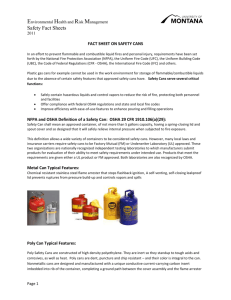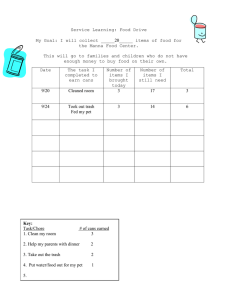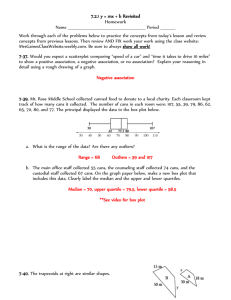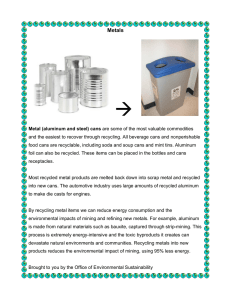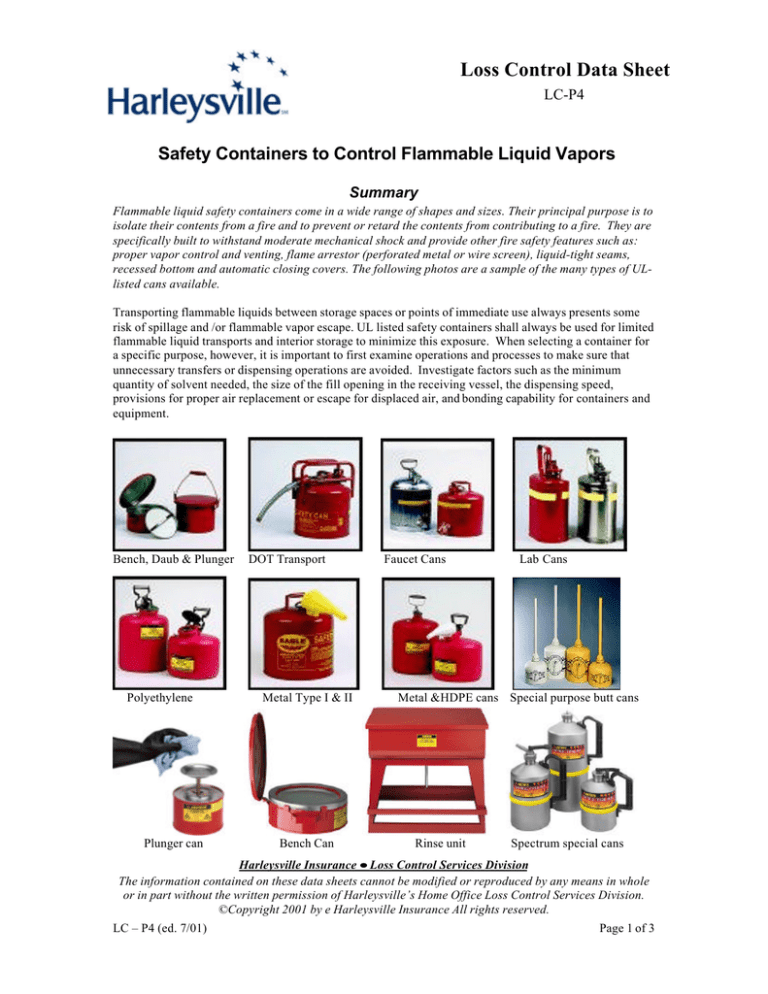
Loss Control Data Sheet
LC-P4
Safety Containers to Control Flammable Liquid Vapors
Summary
Flammable liquid safety containers come in a wide range of shapes and sizes. Their principal purpose is to
isolate their contents from a fire and to prevent or retard the contents from contributing to a fire. They are
specifically built to withstand moderate mechanical shock and provide other fire safety features such as:
proper vapor control and venting, flame arrestor (perforated metal or wire screen), liquid-tight seams,
recessed bottom and automatic closing covers. The following photos are a sample of the many types of ULlisted cans available.
Transporting flammable liquids between storage spaces or points of immediate use always presents some
risk of spillage and /or flammable vapor escape. UL listed safety containers shall always be used for limited
flammable liquid transports and interior storage to minimize this exposure. When selecting a container for
a specific purpose, however, it is important to first examine operations and processes to make sure that
unnecessary transfers or dispensing operations are avoided. Investigate factors such as the minimum
quantity of solvent needed, the size of the fill opening in the receiving vessel, the dispensing speed,
provisions for proper air replacement or escape for displaced air, and bonding capability for containers and
equipment.
Bench, Daub & Plunger
Polyethylene
Plunger can
DOT Transport
Metal Type I & II
Bench Can
Faucet Cans
Lab Cans
Metal &HDPE cans Special purpose butt cans
Rinse unit
Spectrum special cans
Harleysville Insurance • Loss Control Services Division
The information contained on these data sheets cannot be modified or reproduced by any means in whole
or in part without the written permission of Harleysville’s Home Office Loss Control Services Division.
©Copyright 2001 by e Harleysville Insurance All rights reserved.
LC – P4 (ed. 7/01)
Page 1 of 3
Description of Can Usage
• Safety Plunger Cans are ideal for cleaning with flammable or volatile fluids. They feature brass flame
arrestor dasher screens and pump assemblies and comply with OSHA standards. When the dasher plate is
pushed down, the safety can dispenses a small amount of liquid to easily moisten sponges or rags without
messy or dangerous spills.
• DOT Transport safety can helps reduce the danger of explosion while dispensing flammable liquids
through a flexible metal spout. Can has double-walled brass flame arrestors in filler opening and pour
spout. Heavy-duty roll bars protect both spouts and a thumb screw mechanism assures that the filler
opening stays closed while being transported. Meets DOT requirements.
• Faucet cans easily dispense flammable liquids into small capacity vessels using self-closing dispensing
faucet. Typical use is for use workbenches or elevated shelves
• Lab Cans constructed of Coated Metal, Stainless, or Polyethylene Used in scientific, industrial, and
hospital laboratories. Reduces the danger of explosions resulting from ignition of vapors of flammable
liquids. FM approved and meets OSHA requirements. Oblong shape conserves shelf space.
• High Density Polyethylene Type I Safety Cans meet OSHA requirements, are Factory Mutual (FM)
approved, and help reduce the danger of explosions resulting from ignition of vapors of flammable liquids.
These cans are impact resistant, non-corroding, and will not rust. They are impervious to many liquid
chemicals, solvents, and corrosives. Metal fittings and flame arrestor are made of stainless steel.
• Type I Steel Safety Cans are made completely of sturdy 24 gauge type 316 stainless steel in 2½ and 5
gallon capacities. Stainless steel flame arrestor. Electric seam weld joins top and body.
• Type II Safety Cans are made of Galvanized Steel and help reduce the danger of explosion while
dispensing flammable liquids through a flexible 12" metal spout. Brass flame arrestors in filler opening and
pour spout.
• Metal and HDPE Disposal Safety Cans provide an intermediate station for temporary storage of liquid
wastes. Spout cap opens to a wide 80° angle and can be locked open for conveniently emptying various
type containers. The can is equipped with a frame arrestor. Cap assembly opens automatically to relieve
excessive internal vapor pressures.
• Butt specialty cans each serve a unique purpose that suits your needs.
• Floor-standing rinse tanks provide space where larger parts can be immersed. There is a self-closing
cover is foot-treadle operated, so a worker with both hands full can open it.
Special Cans have been developed for not only flammable but also other chemicals. Consult a
distributor for the needs of your operation.
Related Information:
Eagle Manufacturing Company
2400 Charles Street
Wellsburg, West Virginia 26070
The Protectoseal Company
225 W. Foster Ave.
Bensenville, IL 60106
Phone: (630) 595-0800
Harleysville Insurance • Loss Control Services Division
The information contained on these data sheets cannot be modified or reproduced by any means in whole
or in part without the written permission of Harleysville’s Home Office Loss Control Services Division.
©Copyright 2001 by e Harleysville Insurance All rights reserved.
LC – P4 (ed. 7/01)
Page 2 of 3
Freund Container
155 West 84th Street
Chicago, IL 60620
Phone: 773.224.4230
Justrite Manufacturing Company
(847) 298-9250
(800) 798-9250
References
Underwriters Laboratories Inc., 333 Pfingsten Road, Northbrook, IL 60062.
UL 2080, Standard for Fire Resistant Tanks for Flammable and Combustible Liquids, 2000.
NFPA 70, National Electrical Code®, 1999 edition.
NFPA 88B, Standard for Service Stations and Repair Garages 1999 edition.
NFPA 220, Standard on Types of Building Construction, 1999 edition.
NFPA 230, Standard for the Fire Protection of Storage, 1999 edition.
ASTM D 92, Standard Test Method for Flash and Fire Points by Cleveland Open Cup, 1998.
ASTM D 93, Standard Test Methods for Flash Point by the Pensky-Martens Closed Tester, 1999.
ASTM D 323, Standard Method of Test for Vapor Pressure of Petroleum Products (Reid Method), 1999.
ASTM D 3278, Standard Method of Tests for Flash Point of Liquids by Setaflash Closed Tester, 1996.
ASTM D 3828, Standard Test Methods for Flash Point by Small Scale Closed Tester, 1998.
ASTM F 852, Standard for Portable Gasoline Containers for Consumer Use, 1999.
The information and suggestions contained in this data sheet have been developed from sources believed to
be reliable. However, we accept no legal responsibility for the correctness or completeness of this material
or its application to specific factual situations. . Internet distributor links included represent the content of
this data sheet and are not to be construed as solicited distributors. If more information is needed, please
contact the Harleysville Loss Control Department and report non-functioning links to or
ccampbel@harleysvillegroup.com
Harleysville Insurance • Loss Control Services Division
The information contained on these data sheets cannot be modified or reproduced by any means in whole
or in part without the written permission of Harleysville’s Home Office Loss Control Services Division.
©Copyright 2001 by e Harleysville Insurance All rights reserved.
LC – P4 (ed. 7/01)
Page 3 of 3

